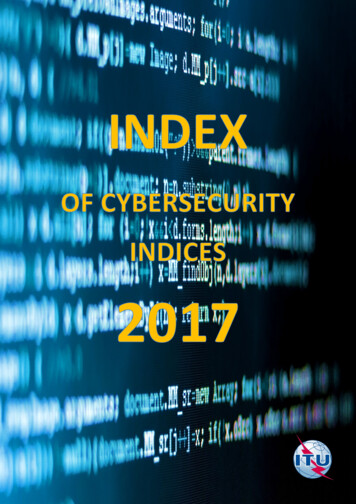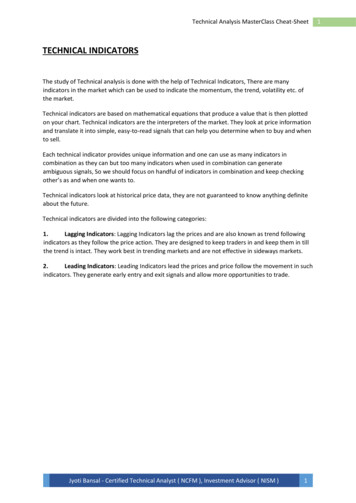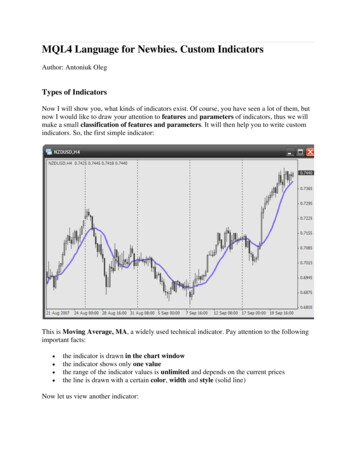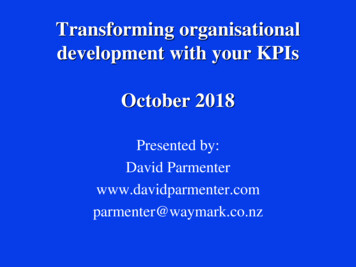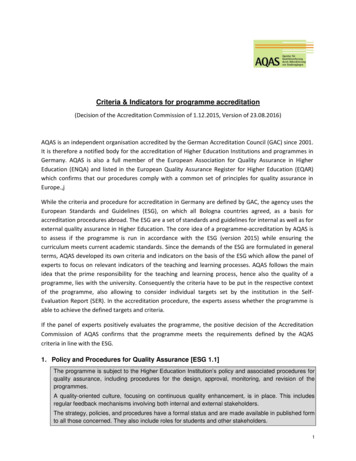
Transcription
Criteria & Indicators for programme accreditation(Decision of the Accreditation Commission of 1.12.2015, Version of 23.08.2016)AQAS is an independent organisation accredited by the German Accreditation Council (GAC) since 2001.It is therefore a notified body for the accreditation of Higher Education Institutions and programmes inGermany. AQAS is also a full member of the European Association for Quality Assurance in HigherEducation (ENQA) and listed in the European Quality Assurance Register for Higher Education (EQAR)which confirms that our procedures comply with a common set of principles for quality assurance inEurope.,jWhile the criteria and procedure for accreditation in Germany are defined by GAC, the agency uses theEuropean Standards and Guidelines (ESG), on which all Bologna countries agreed, as a basis foraccreditation procedures abroad. The ESG are a set of standards and guidelines for internal as well as forexternal quality assurance in Higher Education. The core idea of a programme-accreditation by AQAS isto assess if the programme is run in accordance with the ESG (version 2015) while ensuring thecurriculum meets current academic standards. Since the demands of the ESG are formulated in generalterms, AQAS developed its own criteria and indicators on the basis of the ESG which allow the panel ofexperts to focus on relevant indicators of the teaching and learning processes. AQAS follows the mainidea that the prime responsibility for the teaching and learning process, hence also the quality of aprogramme, lies with the university. Consequently the criteria have to be put in the respective contextof the programme, also allowing to consider individual targets set by the institution in the SelfEvaluation Report (SER). In the accreditation procedure, the experts assess whether the programme isable to achieve the defined targets and criteria.If the panel of experts positively evaluates the programme, the positive decision of the AccreditationCommission of AQAS confirms that the programme meets the requirements defined by the AQAScriteria in line with the ESG.1. Policy and Procedures for Quality Assurance [ESG 1.1]The programme is subject to the Higher Education Institution’s policy and associated procedures forquality assurance, including procedures for the design, approval, monitoring, and revision of theprogrammes.A quality-oriented culture, focusing on continuous quality enhancement, is in place. This includesregular feedback mechanisms involving both internal and external stakeholders.The strategy, policies, and procedures have a formal status and are made available in published formto all those concerned. They also include roles for students and other stakeholders.1
Responsibilities and expectations within the programme and programme elements are clearly defined andavailable to students. Curriculum documentation is up-to-date and updated regularly, with clearly defined expectations. A quality assurance system is in place which is appropriate for the relevant study programme. It isdocumented and comprehensive. It involves instruments with different scopes: course evaluations, programme evaluations, evaluations of student workload, progression & completion rates, evaluations of changing societal needs, and evaluations of the learning environment and support services. Students and the labour market are involved in the quality-assurance procedure for the programme. Experiences from student advisory bodies/groups are used for the enhancement of the programme. The results of quality-assurance procedures lead to concrete measures to enhance quality / resolve identifiedconflicts. Documentation on changes and adjustments made to the programme since the last accreditation / in the pastis available. Evaluation results are shared with teaching staff and students. Recommendations from past accreditations/evaluations have been considered. The career progression of graduates from the study programme is followed and data on alumni experiencesare considered during further development of the study programme.2. Quality of the Curriculum [ESG 1.2]The Intended Learning Outcomes of the programme are defined and available in published form.They reflect both academic and labour-market requirements and are up-to-date with relation to therelevant field. The design of the programme supports achievement of the Intended LearningOutcomes.The academic level of graduates corresponds to the requirements of the appropriate level of theEuropean Qualifications Framework.The curriculum’s design is readily available and transparently formulated.Study Programme Objectives Desired qualifications to be achieved during the programme are presented as Intended Learning Outcomes.They are both subject-specific and interdisciplinary in nature. Intended Learning Outcomes are shown to be appropriate. Proof of their appropriateness can be providedthrough evaluations, graduate surveys, and/or feedback from the labour market. The Intended Learning Outcomes are/were updated according to current developments in theacademic/scientific field or/and labour market. The academic degree awarded to the graduates corresponds to the learning outcomes and the requirementsof the appropriate level of the European Qualifications Framework.Curricular Elements and Programme Quality The curricular structure of the study programme supports the achievement of the learning outcomes. Allcurricular elements (courses/modules) and their functions are documented. The curriculum defines whichelements are compulsory and which are electives. There is an idealized typical course plan available. Theorder of curricular elements supports the learner’s progression. The curriculum covers subject-specific and cross-subject knowledge, as well as subject-related,methodological, and general skills. This is documented on the level of the Intended Learning Outcomes.2
The curriculum defines which elements/courses are offered exclusively for the programme and which partsare used in other programmes. Curricular modifications are documented in a transparent manner and contribute to an improvement inprogramme quality. If the programme has a specific profile (distance education etc.), specifics of this profile are reflected in thedesign of the curriculum and documented. The final thesis / exams demonstrate that the intended level of qualification has been achieved aftercompleting the programme. All elements of the curriculum are assigned a certain number of credits directly related to the expectedworkload. The total programme workload is allocated to the different courses/modules.3. Learning, Teaching and Assessment of Students [ESG 1.3]The delivery of material encourages students to take an active role in the learning process.Students are assessed using accessible criteria, regulations, and procedures, which are made readilyavailable to all participants and which are applied consistently.Assessment procedures are designed to measure the achievement of the Intended LearningOutcomes. Methods of teaching and learning are appropriate to and correspond to the Intended Learning Outcomes. Methods of teaching and learning respect and take into account the diversity of students and their needs,enabling flexible learning paths. Didactic methods stimulate student motivation, self-reflection, and engagement in the learning process. Assessment regulations and procedures are defined and made readily available in published form to students. Assessment methods for each course/module are appropriate for the learning outcomes as defined in thecourse/module description. The programme design ensures that every student is familiarised with an appropriate spectrum ofexamination types over the course of the studies. If there is a choice among different methods for individualexaminations, a mechanism is in place to ensure that students must absolve the desired spectrum of examchoices over the course of the programme. Requirements for the examinations are transparent and made known to the students. Changes to the examination concept are documented and explained. Responsibilities and structures related to the organisation of exams are clearly defined. The timing of examsis organised appropriately and examination dates are announced in a timely manner. Suitable opportunities tore-sit an exam are offered as necessary. There are transparent and published regulations to compensate for disadvantages, illness, absence, or othermitigating circumstances that may affect a student. Long-term data regarding the number of failed course/module examinations in the study programme are usedfor evaluation and to improve the programme. Grading scales and the distribution of grades is documented and assessed. The programme enables students to transfer their knowledge to situations outside the university context.Methods of teaching, learning, and assessment support an interlacing of theoretical and practical aspects.3
4. Student Admission, Progression, Recognition, and Certification [ESG 1.4]Consistently applied, pre-defined, and published regulations are in place which cover studentadmission, progression, recognition, and certification. Formal requirements for admission are clearly defined and available in published for. Specific prerequisitesrelevant for an individual study programme (e.g. language skills, professional experience, artistic ability)reflect substantive qualities needed for a successful completion of the programme and are included in thepublished admissions criteria. The selection procedure for the study programme follows defined criteria and procedures that are publiclyavailable. Admission requirements are shown to support the objectives of the study programme. The admissionrequirements are or have been adjusted when necessary. Qualitative and quantitative data is available on the admission procedures of past cohorts. Regulations for recognition of Higher Education Qualifications, previous periods of study, and prior learning,including the recognition of non-formal and informal learning, are in place. These regulations are documentedin legally binding form and are available to students. Learning agreements are used to facilitate mobility of students. Graduates receive documentation explaining the qualification gained, including context, level, and status ofthe studies (diploma supplement).5. Teaching Staff [ESG 1.5]The composition (quantity, qualifications, professional and international experience, etc.) of the staffis appropriate for the achievement of the Intended Learning Outcomes.Staff involved with teaching is qualified and competent to do so.Transparent procedures are in place for the recruitment and development of staff. Required resources are checked with regard to the capacity of the institution. The successful completion ofthis check is documented. All human resources involved in teaching within the programme are documented, including their academicand other relevant qualifications as well as quantitative involvement (teaching hours) in the programme. Iftheir teaching hours include offerings open to other programmes, this is transparent. It is ensured that long-term accounting of the teaching hours is available for the period of accreditation. Teaching staff positions are either filled, are being advertised, or are in the middle of appointmentproceedings. If contracts expire in the next five to seven years, the intent is to fill the position anew or there isa continuity plan in place. If there are associate/part time lecturers involved in the programme, procedures are in place to ensure thequalifications of these lecturers. Lecturers are to be made familiar with the requirements of the programme. Transparent recruitment procedures for teaching staff are in place. Procedures are in place to ensure and/or develop appropriate didactic qualifications of the teaching staff.4
6. Learning Resources and Student Support [ESG 1.6]Appropriate facilities and resources are available for learning and teaching activities.Guidance and support is available for students to advise on achieving successful completion of theirstudies. Course/module descriptions are available to students. These documents contain the Intended LearningOutcomes, methods of learning and teaching, assessment methods, and the expected workload (self-studyand in-class hours). Strategies are defined to ensure that course offerings are coordinated on both content and organizationallevels to avoid overlap. The programme is implemented in such a way that students are able to complete theirstudies within the expected period of time as defined in the curriculum.Learning Resources Appropriate material resources (finance, computer workplaces, laboratories etc.) are available for the studyprogramme as necessary to achieve the Intended Learning Outcomes. Sufficient facilities are available with regard to room and space required for the number of students in theprogramme. Access is provided to an appropriate amount of literature, journals, and academic sources to enable theachievement of the learning outcomes. The equipment in laboratories and dedicated workspaces reflects current professional standards and isappropriate for the Intended Learning Outcomes.Student Support Services Introductory offerings are available for new and potential students. Institutionalized student advisory services are available to students. These services are offered consistentlyand information on these services is made available to students in an adequate way; specialized informationsessions are offered regularly. Individualized advising for specific programmes/programme content is provided. Teaching staff members offerfrequent consultation hours and are available to students. Specific offerings are available for exchange students / incoming students. If the study programme includes practical phases/internships, credits are awarded for these and students aregiven support in finding practical placements. Student diversity is considered when allocating, planning, and providing learning resources and studentsupport.7. Information [ESG 1.7 & 1.8]Data is collected from relevant sources and stakeholders, analysed, and used for the effectivemanagement and continuous enhancement of the programme.Impartial and objective, up-to-date information regarding the programme and its qualifications ispublished regularly. This published information is appropriate for and available to relevantstakeholders.Data Management Information on the labour market requirements are collected and analysed. A clear and comprehensibledescription of potential employment fields for graduates is available. Information is available on which sectors graduates are employed in and on how many graduates continue infurther education programmes (Master-, PhD-programmes etc.). Information from other relevant sources is collected and used as required. Information on the composition of the student body of the study programme is available.5
Information on the duration of studies is available. The analysis of this information can lead to changes in thestudy program, the consequences of which are documented. It is documented how many students do not complete their studies. The reasons for non-completion are alsodocumented.Public Information Information is provided to the public on:o the programme,o Intended Learning Outcomes,o selection procedure,o qualifications awarded, ando teaching, learning and assessment procedures.6
Criteria & Indicators for programme accreditation (Decision of the Accreditation Commission of 1.12.2015, Version of 23.08.2016) AQAS is an independent organisation accredited by the German Accreditation Council (GAC) since 2001. It is therefore a notified body for the accreditation of Higher Education Institutions and programmes in Germany.

